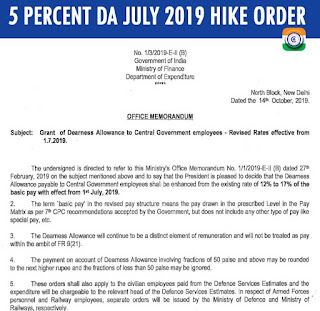Bureaucracy delaying higher allowances implementation
New
Delhi: Complicated bureaucracy is delaying the implementation of the
higher allowances under 7th Pay Commission recommendations, and it is
now expected to start in three to four months, one leader of an
employees union was quoted as saying.
The government has given
higher basic pay with arrears, effective from January 1, 2016 in August
2016 to its employees on the recommendations of the 7th pay commission
but referred hike in allowances other than dearness allowance to the
‘Committee on Allowances’ headed by the Finance Secretary Ashok Lavasa
for examination in July, 2016 as the 7th pay commission had recommended
for abolishing 51 allowances and subsuming 37 others out of 196
allowances.
The government has given the committee four months to
submit the report but an extension was also given up to February 22,
2017 to submit its report on higher allowances. In October last year,
Finance Secretary Ashok Lavasa had said the committee was ready with its
report.
Usually, once the recommendations of the pay commission
are approved, the increase in basic pay is followed by an increase in
allowances.
The government earlier said that the cash crunch was the reason behind the delay in
announcing higher allowances.
The
announcement of assembly elections in five states has also given an
excuse for the government as it cannot announce allowances hikes till
the model code of conduct is in place up to March 8.
The higher
House Rent Allowance (HRA) segment is of great benefit to central
government employees in the allowances.This segment will more than
double, with the increases ranging between 106% and 122% as recommended
the 7th Pay Commission. So, the central government employees have a keen
interest in higher House Rent Allowance (HRA).
The pay commission has recommended the rates HRA for these cities to 24%, 16% and 8%
respectively of new pay matrix.
The
Commission also recommended, that the rate of HRA will be revised to 27
percent, 18 percent and 9 percent respectively when DA crosses 50
percent, and further revised to 30 percent, 20 percent and 10 percent
when DA crosses 100 percent.
The existing rates of HRA for Class
X, Y and Z cities and towns are 30%, 20% and 10% of Basic pay (old pay
in the pay band plus grade pay) are now paid to the central government
employees according to the 6th Pay Commission recommendations until
issuing of higher allowances notification.
The top bureaucrats
living government bungalows and plush flats in the posh East Moti Bagh
area in New Delhi. So, they don’t take House Rent Allowance (HRA).
‘The
top bureaucrats houses have modular kitchens, hot and cold water supply
like in hotels, solar lighting, a club with a swimming pool and tennis
courts, jogging tracks, terrace gardens, a shopping complex, a primary
school and banking facilities,’ an official at the urban development
ministry said. They are also taking benefit of yoga and health centre.
The
luxury apartments becoming popular among the bureaucrats. The
secretaries of the central departments have been allotted a plot size of
8,250 sq ft, a plint area of 1,970 sq ft, eight bedrooms, four servant
quarters, two garages, front and rear lawns. Hence, they are not
interested to hike allowances and the higher allowances announcement
dips in face of bureaucratic apathy.
However, we hope, the Finance
Minister Arun Jaitley may announce the higher allowances, most probably
after ending the model code of conduct on March 8, which will cover 48
lakh central government employees and 52 lakh pensioners.










